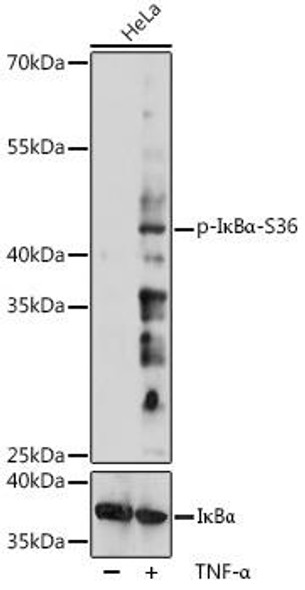Description
| Antibody Name: | Phospho-AHR/AHRR (S36) Antibody |
| Antibody SKU: | PACO02627 |
| Size: | 50ug |
| Host Species: | Rabbit |
| Tested Applications: | ELISA, WB, IHC |
| Recommended Dilutions: | WB:1:500-1:2000, IHC:1:100-1:300 |
| Species Reactivity: | Human, Mouse, Rat |
| Immunogen: | synthesized peptide derived from human Ah Receptor around the phosphorylation site of S36. |
| Form: | Liquid |
| Storage Buffer: | Liquid in PBS containing 50% glycerol, 0.5% BSA and 0.02% sodium azide. |
| Purification Method: | The antibody was affinity-purified from rabbit antiserum by affinity-chromatography using epitope-specific immunogen. |
| Clonality: | Polyclonal |
| Isotype: | IgG |
| Conjugate: | Non-conjugated |
| Synonyms: | AHR; BHLHE76; Aryl hydrocarbon receptor; Ah receptor; AhR; Class E basic helix-loop-helix protein 76; bHLHe76; AHRR; BHLHE77; KIAA1234; Aryl hydrocarbon receptor repressor; AhR repressor; AhRR; Class E basic helix-loop-helix protein 77; bHL |
| UniProt Protein Function: | AHR: a nuclear receptor for aryl hydrocarbons involved in xenobiotic metabolism, cell cycle regulation, and development in response to both endogenous and environmental signals. AhR was initially identified as a receptor for dioxins, which are environmental pollutants generated by waste incineration and other industrial processes. AhR ligands include polycyclic aromatic hydrocarbons, including the carcinogen benzo(a)pyrene and other components of cigarette smoke. Naturally occurring AhR ligands include flavonoids, which are aromatic plant secondary compounds commonly found in vegetables and fruits. Cytoplasmic aryl hydrocarbon receptors are found in protein complexes with heat shock proteins. Upon ligand binding, AhR dissociates from heat shock proteins and translocate to the nucleus where it dimerizes with AhR nuclear translocator (ARNT, HIF-1b). The AhR/ARNT heterodimer binds to nuclear xenobiotic response elements to control the expression of genes associated with xenobiotic metabolism, including several cytochrome P450 genes. AhR is ubiquitously expressed and is thought to play a role in regulation of cell proliferation and differentiation, cytokine expression, and xenobiotic metabolism. Research studies link AhR activity with the control of regulatory T-cell and T-helper 17 cell differentiation, regulation of the inflammatory response, and the onset of lung cancer. |
| UniProt Protein Details: | Protein type:DNA-binding; Transcription factor; Nuclear receptor Chromosomal Location of Human Ortholog: 7p15 Cellular Component: nucleoplasm; transcription factor complex; cytoplasm; nucleus Molecular Function:protein dimerization activity; RNA polymerase II transcription factor activity, enhancer binding; ligand-dependent nuclear receptor activity; protein binding; signal transducer activity; DNA binding; sequence-specific DNA binding; protein heterodimerization activity; Hsp90 protein binding; transcription factor activity; transcription factor binding Biological Process: transcription from RNA polymerase II promoter; prostate gland development; blood vessel development; intracellular receptor-mediated signaling pathway; apoptosis; response to toxin; positive regulation of transcription, DNA-dependent; negative regulation of transcription from RNA polymerase II promoter; cell cycle; regulation of transcription from RNA polymerase II promoter; response to xenobiotic stimulus; regulation of transcription, DNA-dependent; regulation of gene expression; xenobiotic metabolic process; regulation of B cell proliferation; positive regulation of transcription from RNA polymerase II promoter; circadian regulation of gene expression; negative regulation of transcription, DNA-dependent; positive regulation of transcriptional preinitiation complex assembly |
| NCBI Summary: | This gene encodes a ligand-activated transcription factor involved in the regulation of biological responses to planar aromatic hydrocarbons. This receptor has been shown to regulate xenobiotic-metabolizing enzymes such as cytochrome P450. Its ligands included a variety of aromatic hydrocarbons. [provided by RefSeq, Jul 2008] |
| UniProt Code: | P35869 |
| NCBI GenInfo Identifier: | 3041653 |
| NCBI Gene ID: | 196 |
| NCBI Accession: | P35869.2 |
| UniProt Secondary Accession: | P35869,Q13728, Q13803, Q13804, A4D130, |
| UniProt Related Accession: | P35869 |
| Molecular Weight: | 848 |
| NCBI Full Name: | Aryl hydrocarbon receptor |
| NCBI Synonym Full Names: | aryl hydrocarbon receptor |
| NCBI Official Symbol: | AHR |
| NCBI Official Synonym Symbols: | bHLHe76 |
| NCBI Protein Information: | aryl hydrocarbon receptor; AH-receptor; ah receptor; aromatic hydrocarbon receptor; class E basic helix-loop-helix protein 76 |
| UniProt Protein Name: | Aryl hydrocarbon receptor |
| UniProt Synonym Protein Names: | Class E basic helix-loop-helix protein 76; bHLHe76 |
| Protein Family: | Aldehyde reductase |
| UniProt Gene Name: | AHR |
| UniProt Entry Name: | AHR_HUMAN |






